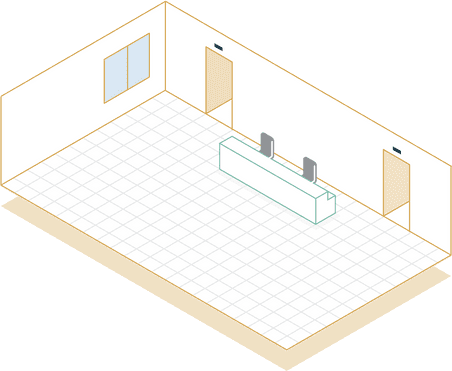Universal Design Considerations
Simple measures can make a big difference to the look, feel and safe operation of your practice.
Apply these measures throughout your practice:
- Soundproofing
- Easy to clean flooring
- An area dedicated to the cleaning, sterilisation and storage of medical supplies and vaccines
- Clinical equipment and clinical waste located at a height that is inaccessible to children.

Accomodating disability and special needs
A well designed pratice ensures that people with disability or special needs can access the practice and its services in ways that maintain their dignity.
To make your practice accessible, consider patients with disabilities when deciding on the height of reception desks, doorknobs, sinks and hand-driers in bathrooms.
Furniture and Non-Clinical Equipment
Good furniture and equipment is functional, durable and asethetically pleasing. Take the time to choose well - this is an investment for your practice.
Desks
- Desks should be between 750 mm x 1500 mm and 900 mm x 1800 mm in size.
- Desk heights should be between 680 mm – 720 mm.
- Choose desks with rounded corners, as sharp corners can be hazardous.
- Consider desks that can convert from a seated to a standing position.
Office Chairs
- Good quality office chairs promote good musculoskeletal health and avoid fatigue.
- Ensure that chairs have controls so that staff can adjust the seat height and backrest.
Patient Chairs
Ensure adequate, comfortable and functional seating throughout all areas of your practice. Bariatric chairs and chairs with arm rests will help to accomodate the needs of people who are elderly, overweight or mobility imparired. Provide at least one of each chair in all rooms and spaces throughout your practice and consider more than one bariatric chair in your waiting area.
Examination Beds
To be accredited against the RACGP Standards for General Practices, your practice must have at least one height-adjustable bed.

Cold Chain
Your practice will need dedicated refrigeration for vaccines. Vaccines can become less effective or be destroyed if they are not kept within an optimal temperature range or are exposed to direct ultraviolet (UV) light, so you will need a process for managing temperature-controlled storage and distribution, known as a cold chain.
Stationary and Printed Materials
Printed materials communicate important information and are a part of you practice's brand identify. Think about:
- personalised stationery (eg letterhead, business cards)
- appointment cards
- self-inking rubber stamps (with the doctor’s name, qualifications, practice address, telephone number and prescriber number)
- brochures and fact sheets
- policies to display (eg in reception and waiting areas)
- computer prescription paper and personalised prescription pads (available from the Department of Human Services)

Desks
- Desks should be between 750 mm x 1500 mm and 900 mm x 1800 mm in size.
- Desk heights should be between 680 mm – 720 mm.
- Choose desks with rounded corners, as sharp corners can be hazardous.
- Consider desks that can convert from a seated to a standing position.
Office Chairs
- Good quality office chairs promote good musculoskeletal health and avoid fatigue.
- Ensure that chairs have controls so that staff can adjust the seat height and backrest.
Patient Chairs
Ensure adequate, comfortable and functional seating throughout all areas of your practice. Bariatric chairs and chairs with arm rests will help to accomodate the needs of people who are elderly, overweight or mobility imparired. Provide at least one of each chair in all rooms and spaces throughout your practice and consider more than one bariatric chair in your waiting area.
Examination Beds
To be accredited against the RACGP Standards for General Practices, your practice must have at least one height-adjustable bed.

Cold Chain
Your practice will need dedicated refrigeration for vaccines. Vaccines can become less effective or be destroyed if they are not kept within an optimal temperature range or are exposed to direct ultraviolet (UV) light, so you will need a process for managing temperature-controlled storage and distribution, known as a cold chain.
Stationary and Printed Materials
Printed materials communicate important information and are a part of you practice's brand identify. Think about:
- personalised stationery (eg letterhead, business cards)
- appointment cards
- self-inking rubber stamps (with the doctor’s name, qualifications, practice address, telephone number and prescriber number)
- brochures and fact sheets
- policies to display (eg in reception and waiting areas)
- computer prescription paper and personalised prescription pads (available from the Department of Human Services)

Desks
- Desks should be between 750 mm x 1500 mm and 900 mm x 1800 mm in size.
- Desk heights should be between 680 mm – 720 mm.
- Choose desks with rounded corners, as sharp corners can be hazardous.
- Consider desks that can convert from a seated to a standing position.
Office Chairs
- Good quality office chairs promote good musculoskeletal health and avoid fatigue.
- Ensure that chairs have controls so that staff can adjust the seat height and backrest.
Patient Chairs
Ensure adequate, comfortable and functional seating throughout all areas of your practice. Bariatric chairs and chairs with arm rests will help to accomodate the needs of people who are elderly, overweight or mobility imparired. Provide at least one of each chair in all rooms and spaces throughout your practice and consider more than one bariatric chair in your waiting area.
Examination Beds
To be accredited against the RACGP Standards for General Practices, your practice must have at least one height-adjustable bed.

Cold Chain
Your practice will need dedicated refrigeration for vaccines. Vaccines can become less effective or be destroyed if they are not kept within an optimal temperature range or are exposed to direct ultraviolet (UV) light, so you will need a process for managing temperature-controlled storage and distribution, known as a cold chain.
Stationary and Printed Materials
Printed materials communicate important information and are a part of you practice's brand identify. Think about:
- personalised stationery (eg letterhead, business cards)
- appointment cards
- self-inking rubber stamps (with the doctor’s name, qualifications, practice address, telephone number and prescriber number)
- brochures and fact sheets
- policies to display (eg in reception and waiting areas)
- computer prescription paper and personalised prescription pads (available from the Department of Human Services)

Clinical Equipment
Adequate clinical equipment is essential for any practice. You will need enough equipment to provide comprehensive clinical care and emergency resuscitation. The RACGP Standards for General Practices provides a list of equipment that practices need for accreditation against the standards.
Click the links below to see the list of equipments:
Lighting
Your practice will need adequate lighting to ensure practice staff can safely complete their work, both administrative and clinical, and so that patients and staff can navigate around the practice. Make the most of natural light where possible.
For more information on lighting see the Australian Standard AS 1680.2.2 – 2008: Interior and workplace lighting, part 2.2 Specific applications—Office and screen-based tasks
Lighting can also set the ambient feeling for patients. A warm white lighting (2700-3000 k) is generally considered to be more calming and comfortable. Use lights of the same lux level within each room, and ideally throughout the practice. If you need, lux levels can be measured by an electrician.To minimise glare from windows, and overhead or reflected lighting:
- avoid facing monitors directly towards or away from external windows
- adjust overhead lights to the correct lux level
- use anti-glare filters if other measures have not succeeded.
Heating, cooling and ventilation
The optimal comfort for sedentary work is 20-26°C, depending on factors such as the season and clothing worn. Keep in mind the comfort of patients who need to disrobe for some examinations and procedures.
By installing insulation, and carefully designing the layout of your practice (including windows and ventilation), you can minimise the need to use air-conditioning and heating systems.Lighting
Your practice will need adequate lighting to ensure practice staff can safely complete their work, both administrative and clinical, and so that patients and staff can navigate around the practice. Make the most of natural light where possible.
For more information on lighting see the Australian Standard AS 1680.2.2 – 2008: Interior and workplace lighting, part 2.2 Specific applications—Office and screen-based tasks
Lighting can also set the ambient feeling for patients. A warm white lighting (2700-3000 k) is generally considered to be more calming and comfortable. Use lights of the same lux level within each room, and ideally throughout the practice. If you need, lux levels can be measured by an electrician.To minimise glare from windows, and overhead or reflected lighting:
- avoid facing monitors directly towards or away from external windows
- adjust overhead lights to the correct lux level
- use anti-glare filters if other measures have not succeeded.
Heating, cooling and ventilation
The optimal comfort for sedentary work is 20-26°C, depending on factors such as the season and clothing worn. Keep in mind the comfort of patients who need to disrobe for some examinations and procedures.
By installing insulation, and carefully designing the layout of your practice (including windows and ventilation), you can minimise the need to use air-conditioning and heating systems.Lighting
Your practice will need adequate lighting to ensure practice staff can safely complete their work, both administrative and clinical, and so that patients and staff can navigate around the practice. Make the most of natural light where possible.
For more information on lighting see the Australian Standard AS 1680.2.2 – 2008: Interior and workplace lighting, part 2.2 Specific applications—Office and screen-based tasks
Lighting can also set the ambient feeling for patients. A warm white lighting (2700-3000 k) is generally considered to be more calming and comfortable. Use lights of the same lux level within each room, and ideally throughout the practice. If you need, lux levels can be measured by an electrician.To minimise glare from windows, and overhead or reflected lighting:
- avoid facing monitors directly towards or away from external windows
- adjust overhead lights to the correct lux level
- use anti-glare filters if other measures have not succeeded.
Heating, cooling and ventilation
The optimal comfort for sedentary work is 20-26°C, depending on factors such as the season and clothing worn. Keep in mind the comfort of patients who need to disrobe for some examinations and procedures.
By installing insulation, and carefully designing the layout of your practice (including windows and ventilation), you can minimise the need to use air-conditioning and heating systems.
